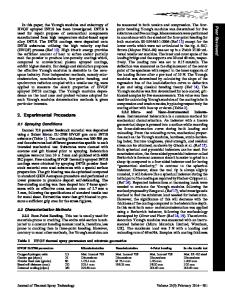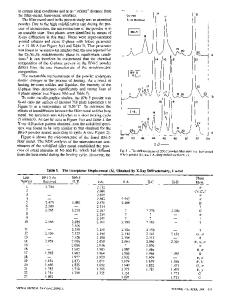Cold Spray Forming of Inconel 718
- PDF / 1,005,498 Bytes
- 9 Pages / 593.972 x 792 pts Page_size
- 91 Downloads / 461 Views
W. Wong, E. Irissou, P. Vo, M. Sone, F. Bernier, J.-G. Legoux, H. Fukanuma, and S. Yue (Submitted June 28, 2012; in revised form September 14, 2012) Inconel 718 was cold spray formed to a 6-mm thickness on an 8-cm diameter aluminum alloy tube using Sulzer Amdry 1718 powder and the Plasma Giken PCS-1000 cold spray system. The effects of spray particle velocity and post-spray heat treatment were studied. Post-spray annealing was performed from 950 to 1250 °C for 1-2 h. The resulting microstructures as well as the corresponding mechanical properties were characterized. As-sprayed coatings exhibited very low ductility. The tensile strength and ductility of the heat-treated coatings were improved to varying levels depending on the heat-treatment and spray conditions. For coatings sprayed at higher particle velocity and heat treated at 1250 °C for 1 h, an elongation of 24% was obtained. SEM micrographs showed a higher fraction of interparticle metallurgical bonds due to some sintering effect. Corresponding fracture surfaces also revealed a higher fraction of dimple features, typically associated with ductile fracture, in the annealed coatings. The results demonstrate that cold spray forming of Inconel 718 is feasible, and with appropriate heat treatment, metallurgical bonding can be increased. The ductility of the spray-formed samples was comparable to that of the bulk material.
Keywords
coatings for engine components, cold spray, cold gas dynamic spraying, Inconel, mechanical properties, spray forming
1. Introduction Cold gas dynamic spray (cold spray) is a coating technique that uses high-pressure compressed gas to propel micron-sized solid particles onto a substrate under atmospheric conditions (Ref 1, 2). Upon impact, the powder particles plastically deform, and, if they reached a critical velocity, adhere to form a coating (Ref 3-5). With cold spray, there is tremendous potential to manufacture thick coatings because of its ability to produce dense coatings with minimal heat input (Ref 6, 7). Thus, cold spray makes it possible to spray form or repair components (Ref 8). For This article is an invited paper selected from presentations at the 2012 International Thermal Spray Conference and has been expanded from the original presentation. It is simultaneously published in Thermal Spray 2012: Proceedings of the International Thermal Spray Conference, Air, Land, Water, and the Human Body: Thermal Spray Science and Applications, Houston, Texas, USA, May 21-24, 2012, Basil R. Marple, Arvind Agarwal, Laura Filofteia-Toma, Margaret M. Hyland, Yuk-Chiu Lau, Chang-Jiu Li, Rogerio S. Lima, and Andre´ McDonald, Ed., ASM International, Materials Park, OH, 2012. W. Wong, E. Irissou, F. Bernier, and J.-G. Legoux, National Research Council Canada, Boucherville, QC, Canada; P. Vo, National Research Council Canada, Boucherville, QC, Canada and, Department of Mining and Materials Engineering, McGill University, Montreal, QC, Canada; M. Sone and H. Fukanuma, Plasma Giken Co., LTD., Tokyo, Japan; and S. Yue, Department of Mining and Ma
Data Loading...











